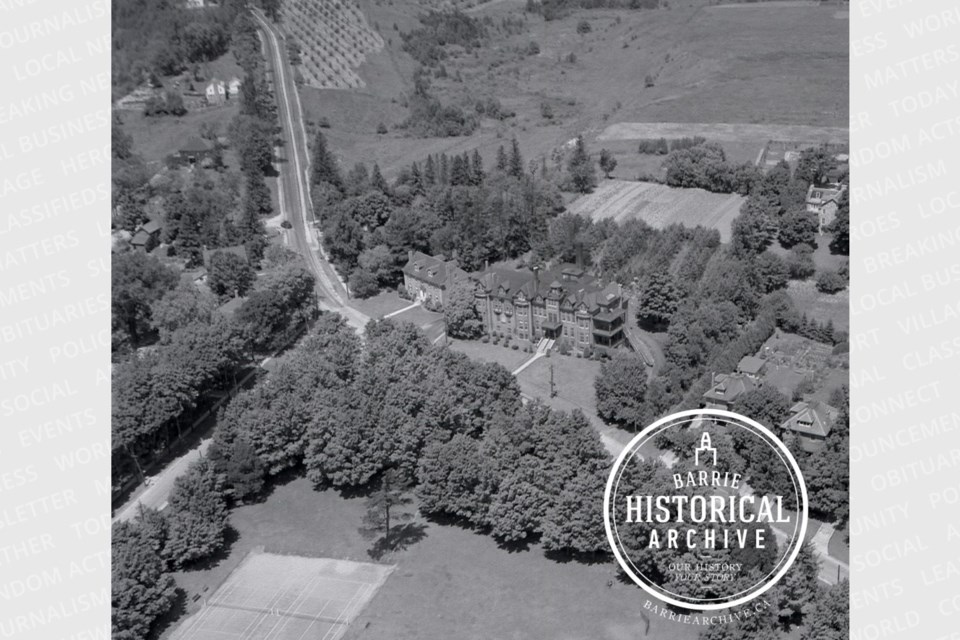This ongoing series from Barrie Historical Archive curator Deb Exel shows old photos from the collection and one from the present day, as well as the story behind them.
Sunnidale Road
Sunnidale Road is about to be bridge-less, at least temporarily. Ongoing construction along Highway 400 through Barrie means a new bridge for this old neighbourhood.
Sunnidale Road is one of the oldest streets in Barrie, the southern end of the road once part of the Nile Mile Portage trail. Deputy surveyor Thomas Kelly was charged with surveying the Township of Sunnidale in 1831 and 1832. The legend is the township was named when an Englishman became lost and encountered an Indigenous settlement in a “sunny dale close to a big river and in sight of the lake.”
In 1833, Richard and Thomas Drury and Alexander Walker opened almost 18 kilometres of Sunnidale Road, as far as the Nottawasaga River.
Sunnidale Road was described as a “mere wagon track through the forest,” and even more than 10 years later, it was still rated anything but easy or safe to travel, given swamps and other rough terrain along the route.
In the Town of Barrie, the section of Sunnidale Road between Bayfield and Wellington streets would be renamed Ross Street by the 1850s.
Sunnidale Road, considered the outskirts of town, would develop in interesting ways. Two urban cemeteries would relocate to Sunnidale Road — St. Mary’s Cemetery, consecrated in 1867, and Barrie Union Cemetery, which opened in 1879.
In the 1870s, affluent citizens began building their mansions on or near Sunnidale Road: Duncan Murchison’s Woodlawn, William Lount’s The Oaks, Frederick Smith’s Bellevoir, and George Plaxton’s First Place.
The Barrie Country Club built its nine-hole golf course on Sunnidale Road in 1913. Although not directly on Sunnidale Road, look at these 1914 plans for a subdivision between Sunnidale Road and Toronto Street.
The pleasant road that led through a quiet neighbourhood, and then into pastoral and wooded land, was about to go through some changes in the early 1950s. Sunnidale Road would soon have an overpass above a new four-lane highway.
Before Highway 400, there were two routes from Toronto to Barrie: Highway 11 and Highway 27. The importance of having a divided, multi-lane highway to the numerous recreation areas near or beyond Barrie, as well as access to the natural resources of the north, cannot be overstated.
Although the idea of a divided highway from Barrie to Toronto was not a new one, it wasn’t until after the Second World War that construction began. After almost six years, in June 1952, all four lanes were open from Toronto to Highway 27 in Barrie.
The Barrie Bypass portion of Highway 400, which connected to highways 11 and 93, opened in August 1952.
Young Bob Halfyard lived at 87 Wellington St., just steps from Sunnidale Road, when the 400 was being built. His family took several photos of the construction happening in their neighbourhood. Similar work was also going on not far away, on Bayfield Street.
Astonishingly, as late as 1960, St. Vincent Street bisected Highway 400 — no bridge. Drivers would stop, look both ways, and then motor directly across the highway.
Similarly, entering the 400 North or South at this crossroad was a simple right-hand turn, and exiting the highway at St. Vincent Street was done as easily as making a left- or right-hand turn onto any city street.
Sunnidale Road residents closest to the highway have had a front-row seat to the coming bridge construction and preparations. Several homes have already been demolished, such as the lovely one that once stood at 84 Sunnidale Rd. The final owners of the charming home shared some of the history of the house built in 1952 by William Elmer Bowness.
William and his brother, Brice, were builders in the area at that time. William built the dwelling at 80 Sunnidale Rd., and then built the solid stone house at 84 Sunnidale Rd., the dream home of his wife, Frances. The beautiful home was situated such on its lot that it was afforded a clear line of sight up Sunnidale Road to the park and, of course, a close-up view of its venerable neighbour, Woodlawn. The home would have several occupants over the years: lawyers, teachers, designers, and Dr. Asquith, a pediatrician.
But it was a young couple who knew at 18, when they saw the enchanting stone house, that it was their dream to live in this home one day. Remarkably, the stars aligned in 2009 and the couple, Kathryn and Jay Johnson, by then in retirement, finally lived in their dream home: 84 Sunnidale Rd.
The Johnsons poured an abundance of love and care into the top-to-bottom renovation of the home fate had finally delivered. Their attractive house was surrounded by beautiful gardens and a manmade pond out back, a spot enjoyed by ducks each spring.
Sadly, the Ministry of Transportation expropriated the property for the Sunnidale Road bridge replacement project and the Johnsons sold their cherished dream home in 2019. It was demolished in 2021.
So, as one bridge opens, another one closes.



